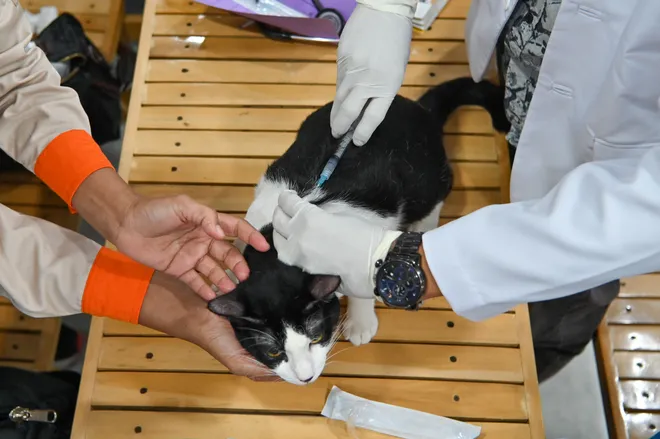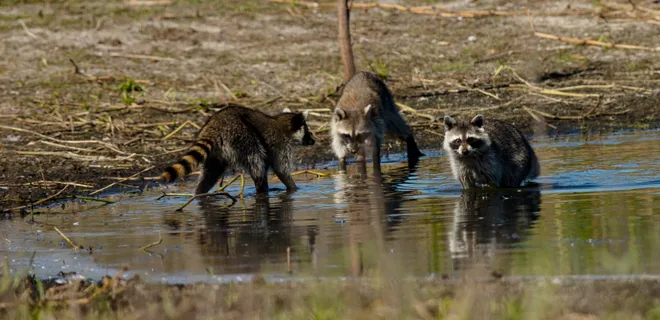This rabies strain was never west of the Appalachians, until a stray kitten showed up in Nebraska
A stray kitten is partly responsible for a multi-agency effort to extinguish a strain of rabies, commonly found in raccoons, that had never been seen west of the Appalachian Mountains.
It all started when the Wahl family brought a black-and-white stray kitten, a little over a month old back to their Omaha home after a friend found the stray meowing in her driveway, according to reporting by the Washington Post.
The tiny feline, named Stanley was taken to a local veterinarian not long after the Wahls brought him home for what appeared to be a bad reaction to ringworm medication, shaking and flailing his legs after each dose.
He had also stopped eating and developed seizures, appearing to get sicker as time went on.
Sharon Mix, a veterinarian at VCA Animal Medical Center of Omaha noted that the kitten’s unusual physical symptoms could be the result of nearly two dozen possible causes.
Rabies was never on the list, since its rare to see in domesticated animals, Mix told The Post. Stanley died a couple days later, exhibiting neurological symptoms worth testing.
The stray kitten tested positive for raccoon rabies on Sept. 28, prompting the creation of a joint taskforce about a week later, including Douglas County, Nebraska, public health officials, the USDA’s Wildlife Services and the rabies epidemiology team at Centers for Disease Control and Prevention assigned to vaccinate racoons in the area against possible infection.

The CDC was able to confirm the result of Stanley’s test on Oct. 6, elevating the response quickly to prevent the virus becoming established in the area, CDC epidemic intelligence service officer Dr. Sydney Stein shared with the Omaha World-Herald.
If left untreated, the disease could spread outside of Omaha and into surrounding areas by way of the racoon population. The strain could make its way towards South Dakota, Minnesota, Iowa, Missouri and Kansas, endangering an estimated 7 million residents, a CDC official shared with The Post.
“My first thought was, ‘It has to be a mistake,’” said Ryan Wallace, who heads the rabies epidemiology team at the CDC.
Here’s what we know.
What happened to the people who came in contact with Stanley?
The 10 people who who were around Stanley, including Rich and Madeline Wahl, Mix, veterinary staff and the family who initially found the stray kitten have received four doses of the rabies vaccine and one dose of human rabies immune globulin to neutralize the virus, according to the CDC.
Everyone involved in Stanley’s care began treatment and are doing well, Omaha World-Herald reported.
What has been done to mitigate the racoon rabies strain?

In the days and months following Stanley’s death, surveillance and vaccination efforts have been conducted by more than a dozen USDA wildlife biologists and CDC disease detectives.
USDA wildlife biologists have gone to work on luring racoons into traps with anise oil and marshmallows to the vaccinate animals in the hopes of preventing the spread, while CDC scientists have set up labs in trailers to test roadkill in surrounding areas, The Post reported.
About 753 raccoons, 41 skunks, four feral cats and one red fox have been vaccinated around the area the stray kitten was originally found, WaPo reported. Of the 250-plus dead animals collected by the CDC for testing, none of them have tested positive for rabies.
Multiple agencies, including the USDA, has placed 18,000 packets containing the oral rabies vaccine around storm drains, trees and bushes, in the woods near walking paths.
The packets, similar to packaged condiments, come coated with wax and fishmeal to attract the racoons.
The efforts made to mitigate the possible spread were intended to create a “wall of immunity” against the variant among racoon populations in the area, according to the Omaha World-Herald.
“As they chew on it, they are bathing their mouth and tonsils with the vaccine, and that starts the immune reaction,” Richard Chipman, the coordinator of the national rabies program at the U.S. Department of Agriculture shared with the Post.
The practice, of dropping packets with rabies vaccines is one federal officials have used to extinguish the threat of rabies since 1997. About 10 million doses of the vaccine are dropped over 16 states annually, from Maine to Texas.
There has been a 50 percent reduction in the number of rabid raccoons reported across the country due to multi-agency efforts to manage the number of rabies cases.
Normally, the vaccines reach between 30 to 40 percent of an area’s racoon population, but Omaha has a large racoon population. As many as 104 racoons per square mile in certain parts of the city have been reported, Wallace shared with the Post.
What happens next?

Officials won’t find out if the mitigation efforts conducted over the last couple of months have worked until February.
Any other animals that might have come in close contact with Stanley might not show symptoms until December, since the incubation period for the virus ranges between one week to three months, The Washington Post reported.
Scientists will continue to test dead animals for the virus, as this a full-proof way to know what which animals have gotten the virus. The number of tests conduced depends on the availability of dead animals turned over to the CDC.
If the virus has spread prominently through the Omaha area, officials will see between 1 and 5 percent of dead animals testing positive. No dead animals have tested positive so far.
“If we can test [a total] of 500 animals over the next few months through this surveillance program and all are negative, then there is likely no spread in local wildlife,” Wallace told The Post.
Where or how Stanley became infected is still unknown, but officials have hypothesized that a pregnant cat or its kitten were bitten and infected by a racoon in the southeastern United States, where the virus most closely resembles the genetic fingerprint found in Stanley, according to The Post.
The pair, or Stanley made their way to Omaha over time.
“Had my husband not resuscitated him. We likely would have buried the kitten in our yard and not known about him being rabies positive,” Stanley’s former owner Madeline Wahl told the Post.
Contributing: Lena H. Sun, Washington Post; Julie Anderson, Omaha World-Herald

Disclaimer: The copyright of this article belongs to the original author. Reposting this article is solely for the purpose of information dissemination and does not constitute any investment advice. If there is any infringement, please contact us immediately. We will make corrections or deletions as necessary. Thank you.




